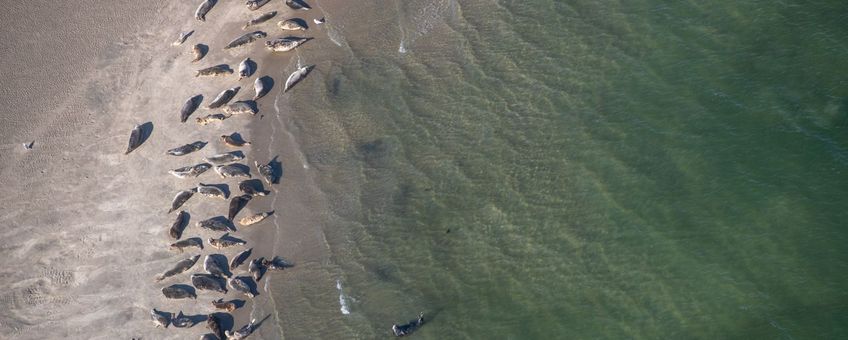
Social distancing seals: evolutionary response to pathogen transmission?
NIOZ Royal Netherlands Institute for Sea ResearchScientists at Royal Netherlands Institute for Sea Research (NIOZ), Wageningen University & Research (WUR) and Swiss Federal Institute of Technology Lausanne (EPFL) have now found that grey seals and harbour seals in the Dutch Wadden Sea display different social distancing. This may be an evolutionary consequence of varying disease susceptibility. Furthermore, the observed differences between grey and harbour seals can be used to differentiate species in aerial surveys.
A cross-disciplinary team of researchers has come up with a new approach to study fine scale distribution patterns of hauled out seals. In their study, published in Royal Society Open Science, they use aerial images to compare between the distribution patterns formed by harbour and grey seal colonies. “By measuring the distance of every seal to its neighbours, we found that harbour seals stay at larger distances from conspecifics than grey seals do”, according to Anne Grundlehner, marine ecologist at Wageningen Marine Research.
Spreading diseases
 This finding is particularly interesting in the context of pathogen transmission. “Harbour seals appear to be less resistant to respiratory viruses than grey seals. Seals in the Wadden Sea for instance, suffered from two outbreaks of the Phocine Distemper Virus (PDV) in 1988 and 2002”, Grundlehner continues. “During these outbreaks, harbour seal populations were reduced by up to 50%, whereas grey seals remained relatively unharmed by the same virus. It is possible that the larger distances we see in harbour seals reflect an evolutionary response to the species’ pathogen susceptibility.”
This finding is particularly interesting in the context of pathogen transmission. “Harbour seals appear to be less resistant to respiratory viruses than grey seals. Seals in the Wadden Sea for instance, suffered from two outbreaks of the Phocine Distemper Virus (PDV) in 1988 and 2002”, Grundlehner continues. “During these outbreaks, harbour seal populations were reduced by up to 50%, whereas grey seals remained relatively unharmed by the same virus. It is possible that the larger distances we see in harbour seals reflect an evolutionary response to the species’ pathogen susceptibility.”
Watching seals from space
The observed patterns are species specific and can therefore serve as a tool for species identification. This is particularly convenient for applications where images are of too low resolution to use morphological characteristics to differentiate between seal species. “Seals can be seen from space”, says Jeroen Hoekendijk, PhD candidate at WUR and NIOZ. “However, in these satellite images a single seal is just a few pixels: generally, not nearly enough to determine the species. By using these spatial haul-out patterns, we now have a new tool to help with species identification in satellite imagery.”
As the method can easily be transferred to other pinnipeds (seals, sea lions, fur seals and walruses), the researchers hope that their new findings provide opportunities to gather more information about pinnipeds in remote and inaccessible regions. Such as the Arctic, where the environment is changing rapidly, and tools are needed to monitor the effects on wildlife.
Living both in the sea and on land
Pinnipeds occupy the boundary between the marine and terrestrial realm. They forage in a marine environment, but depend on land or ice to rest, moult and pup. Most pinniped species tend to cluster together when hauling out on land and may form large aggregations.
The Dutch Wadden Sea is home to two species of pinnipeds: the grey seal and the harbour seal. Both were hunted extensively in the past but have since recovered: grey seal counts now number around 6,500, while almost 8,000 harbour seals were counted.
More information
-
The scientific article Stay close, but not too close: aerial image analysis reveals patterns of social distancing in seal colonies is accesible online.
Text: NIOZ
Photos: Jeroen Hoekendijk, NIOZ (lead photo: grey seals)
